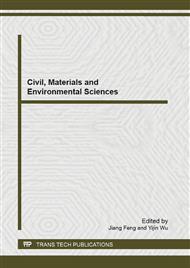[1]
RH. Lumingkewas., H.Purnomo., G.Ausias., D Priadi., T Lecompte., A. Perrot., Tensile Characteristics of coconut fibers reinforced mortar composites, Advanced Materials Research, 2013; (651): 269-273.
DOI: 10.4028/www.scientific.net/amr.651.269
Google Scholar
[2]
RDT Filho., K Scrivener, GL England, K Ghavami. Durability of alkalisensitive sisal and coconut fibres in cement mortar composites. Cement and Concrete Composites 2000; (22):127–43.
DOI: 10.1016/s0958-9465(99)00039-6
Google Scholar
[3]
SS. Munawar., K. Umemura, S. Kawai, Characterization of the morphological, physical, and mechanical properties of seven non-wood plant fibre bundles, J Wood Sci, 2007;53 (2):108–113
DOI: 10.1007/s10086-006-0836-x
Google Scholar
[4]
G Ramakrishna, T Sundararajan. Studies on the durability of natural fibres and the effect of corroded fibres on the strength of mortar. Cement Concrete Composites 2005; 27(5):575–82.
DOI: 10.1016/j.cemconcomp.2004.09.008
Google Scholar
[5]
VM John, MA Cincotto, C Sjostrom, V Agopyan, CTA Oliveira. Durability of slag mortar reinforced with coconut fibre. Cement Concrete Composite 2005; 27(5):565–74.
DOI: 10.1016/j.cemconcomp.2004.09.007
Google Scholar
[6]
A Alida., B. J Shamsul, M. N Mazlee, H Kamarudin., Composite cement reinforced coconut fiber: Physical and mechanical properties and fracture behavior, Australian Journal of Basic and Applied Sciences, 2011;1228-1240.
Google Scholar
[7]
G Ramakrishna, T Sundararajan, Impact strength of a few natural fiber reinforced cement mortar slabs: a comparative study. Cement Concrete Composite 2005; 27(5):547–53.
DOI: 10.1016/j.cemconcomp.2004.09.006
Google Scholar
[8]
P Baruah, S. A Talukdar comparative study of compressive, flexural, tensile and shear strength of concrete with fibres of different origins. Indian Concrete J 2007; 81(7):17–24.
Google Scholar
[9]
Z Li, L Wang, X Wang. Cement composites reinforced with surface modified coir fibers. J Compos Mater 2007;41(12):1445–57.
DOI: 10.1177/0021998306068083
Google Scholar
[10]
M Ali, A Liu, Hou Sou, Nawawi Chouw, Mechanical and dynamic properties of coconut fibre reinforced concrete, Construction and Building Materials, 2012;(30):814–825
DOI: 10.1016/j.conbuildmat.2011.12.068
Google Scholar
[11]
W Wei, H Gu, Characterisation and utilization of natural coconut fibers composites, Materials and Design, 2009; (30):2741–2744.
DOI: 10.1016/j.matdes.2008.11.002
Google Scholar
[12]
H. Khelifi, A. Perrot, T. Lecompte, G. Ausias, Design of clay/cement mixtures for extruded building products, Materials and Structures, published online, 2013;
DOI: 10.1617/s11527-012-9949-4
Google Scholar
[13]
J. Khedari, B. Suttisonk, N. Pratinhong, J. Hirunlabh, New lightweight composite construction materials with low thermal conductivity. Cement Concrete Composite 2001; (23):65–70.
DOI: 10.1016/s0958-9465(00)00072-x
Google Scholar
[14]
RH.Lumingkewas, G.Ausias, T.Lecompte, A. Perrot, I.Katili, H.Purnomo, Microstructural properties of natural coconut fibers-based green mortar composite. Journée de Doctorant de l'Ecole Doctorale SICMA UBS, Lorient, France, (2012)
DOI: 10.4028/www.scientific.net/amr.742.92
Google Scholar
[15]
C Asasutjarit , S Charoenvai , J Hirunlabh , J Khedari, Materials and mechanical properties of pretreated coir-based green composites, Composites: Part B,2009;(40): 633–637
DOI: 10.1016/j.compositesb.2009.04.009
Google Scholar
[16]
W. Wang, G. Huang, Characterisation and utilization of natural coconut fibres composites, Material Design 2009; (30):2741–4
DOI: 10.1016/j.matdes.2008.11.002
Google Scholar
[17]
RH.Lumingkewas, H.Purnomo, G.Ausias, T.Lecompte, A.Perrot, D.Priadi, I. Katili, Properties of Indonesian coconut fibers for cement-based materials reinforcement, Third International Conference on Natural Polymers, Bio-Materials their blends and Gels, Kerala, India, 2012.
DOI: 10.4028/www.scientific.net/amr.742.92
Google Scholar
[18]
D. Romildo, F. Toledo , K. Scrivener, GL. England , K. Ghavami, Durability of alkali-sensitive sisal and coconut fibres in cement mortar composites, Cement & Concrete Composites 2000;(22): 127-143
DOI: 10.1016/s0958-9465(99)00039-6
Google Scholar
[19]
Z. Li, L. Wang, X. Wang, Cement composites reinforced with surface modified coir fibers. J. Comp. Mat., 2007;41(12): 1445-1457.
DOI: 10.1177/0021998306068083
Google Scholar


